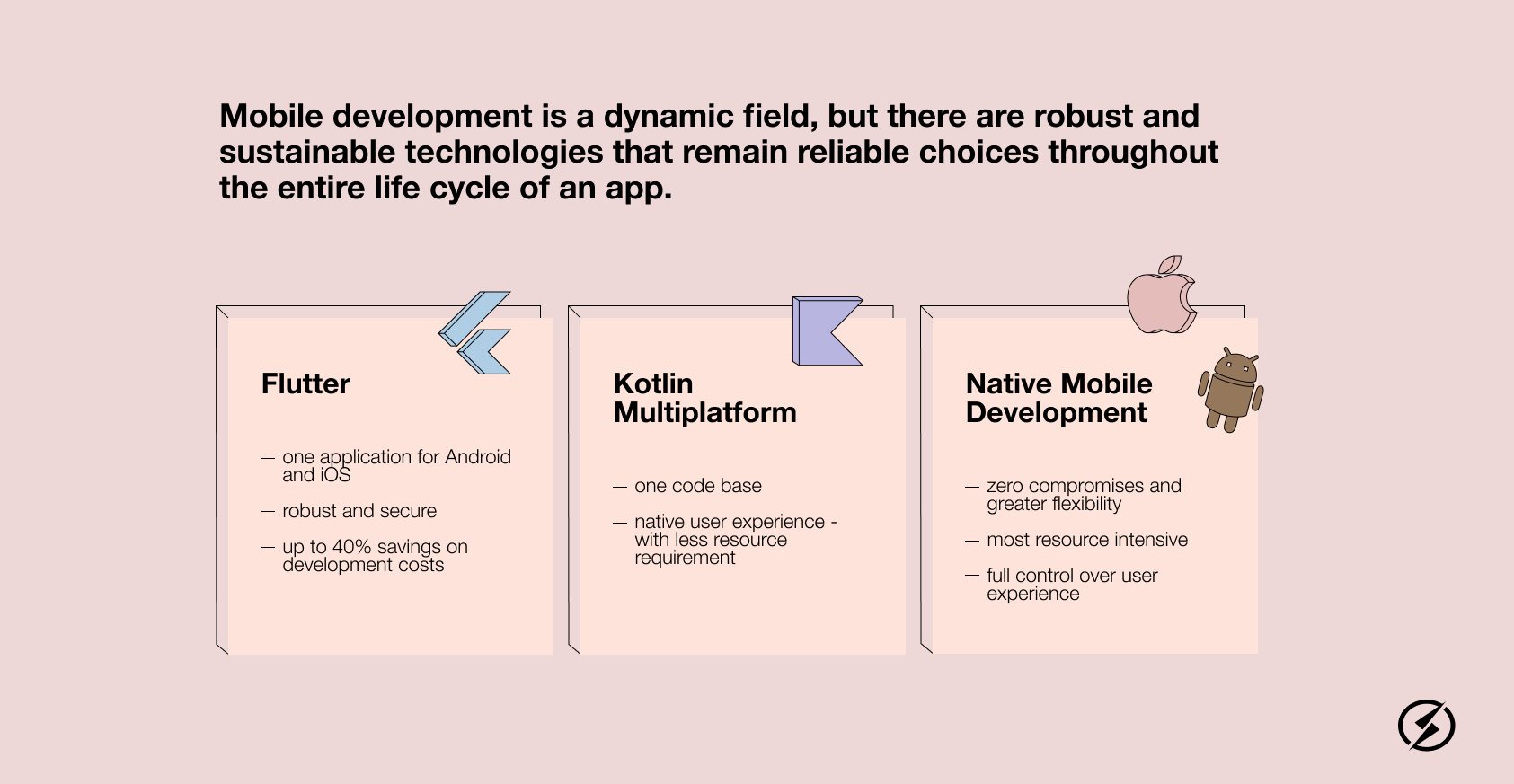share this post on
Is native development the solution for your product?
verify it with our survey 

Choosing the right mobile technology setup is a decision that can significantly impact the trajectory of your business. It's a choice that holds the power to either streamline operations and boost ROI or introduce unforeseen constraints and compromises that may lead to costly maintenance and hinder the expansion of your product down the line.
In an ever-evolving landscape of mobile technologies, making the right choice isn't always straightforward. At Supercharge, we understand the complexities and challenges that come with this decision. In this article, we would like to guide you through the labyrinth of mobile tech options and empower you to make a well-informed choice. In order to simplify the decision-making process, we summarised the pros and cons of the most promising technologies available today.
But that's not all. To provide you with the most tailored guidance possible, we've gone a step further. We've developed a comprehensive survey that assesses your current product and future plans. This survey acts as a compass, helping you navigate through the intricacies of mobile technology selection. By understanding your unique needs and goals, we can assist you in pinpointing the mobile technology that not only aligns with your vision but also maximizes your ROI by cutting your costs.
Your business deserves a mobile technology solution that not only meets your immediate requirements but also sets the stage for long-term success. Join us on this journey as we explore the choices before you, analyze their strengths and weaknesses, and ultimately help you pave the way to a more cost-effective, efficient, and prosperous mobile future.

First, we will examine the default of mobile software engineering: native application development.
Going native entails creating an application that is specifically designed for a mobile platform (typically iOS or Android) using a programming language that is native to the operating system.

The most widely supported language for a given platform may change as programming languages continue to evolve, but, except for brief transitional periods, there is usually a clear choice at any given moment. iOS went from Objective-C to Swift, while Android moved on from Java to Kotlin.
The Pros of going native are plentiful and compelling:
But as with most things in life, there are compromises involved. Let's see the cons of native development:

Secondly, we will examine Flutter, the current cool kid of mobile development that everyone is talking about. “Could it be the tool to slash our development costs?” The same question is being asked by startup founders noodling in converted warehouses and C-level decision makers pondering in glass-panelled boardrooms.
The driving force behind Flutter is Google, which wanted to ensure it had its own contender in the race for the dominant cross-platform solution. With the range of possible devices steadily growing (think foldables, wearables, TVs, AR/VR devices) there is more and more reason to think that the future is cross-platform, as any other options seem increasingly uneconomical.
Flutter is one of the new-gen cross-platform solutions that promise close-to-native performance while offering more secure foundations than React Native.
In this article we focus on the business benefits of using a development framework, so let’s just lightly touch on Flutter's engineering essentials. It is based on Dart, a relatively obscure Programming Language by Google, and Android Studio as its development environment. All this makes it easier for Android developers to transition into Flutter development, but even for folks with a background in iOS, it feels much more “mobile development-like” than the JavaScript-based React Native.
The Pros of Flutter Development
The challenges and possible compromises when going Flutter:

Lastly, we will examine the Kotlin Multiplatform cross-platform framework, which is often overlooked in business decision-maker circles despite its compelling value proposition. However, we expect this to change soon, as Kotlin Multiplatform strikes a perfect balance between native development and cross-platform savings. In our recent client evaluations, it often emerged as the optimal candidate, ticking every box.
Kotlin Multiplatform is a broader initiative aimed at creating cross-platform solutions that can bridge the gap between different platforms, ranging from web to various device-specific platforms, but here, we will focus on its mobile-specific capabilities.
This platform is the brainchild of JetBrains, a Czech company that may not ring a bell for everyone, yet it's the formidable force behind essential components of the Android ecosystem. They've crafted tools like Kotlin, now the official language of Android. Not surprisingly Kotlin is at the core of this cross-platform solution, offering engineers an experience that feels refreshingly native.
Kotlin Multiplatform offers a unique proposition among cross-platform technologies: everything is cross-platform except for the User Interface.
This ingenious solution saves significant time because the business logic, data models, and integrations toward backend services don’t need to be written twice for both mobile platforms, while the UI remains in native code. The result is substantial savings and an entirely native mobile experience. Truly, it's the best of both worlds.
Of course, it is not the best choice for every product, as you will see after reading the list of pros and cons.
The Pros of Kotlin Multiplatform
Like any cross-platform technology, Kotlin Multiplatform Mobile comes with some compromises, but very few this time.

As we wrap up this exploration of the pros and cons of Flutter, Kotlin Multiplatform, and Native development, we hope you've found this summary both informative and enlightening. Making the right choice in mobile technology is a pivotal decision, and we believe that understanding the strengths and weaknesses of each option is the first step toward success.
However, we understand that your business is unique, and your path to ROI optimization may have its own distinct twists and turns. That's where our comprehensive survey comes into play.
If you have any doubts or seek personalized guidance tailored to your specific business needs, we invite you to take our survey. With your input, we can provide you with a well-informed recommendation that aligns perfectly with your vision and goals.